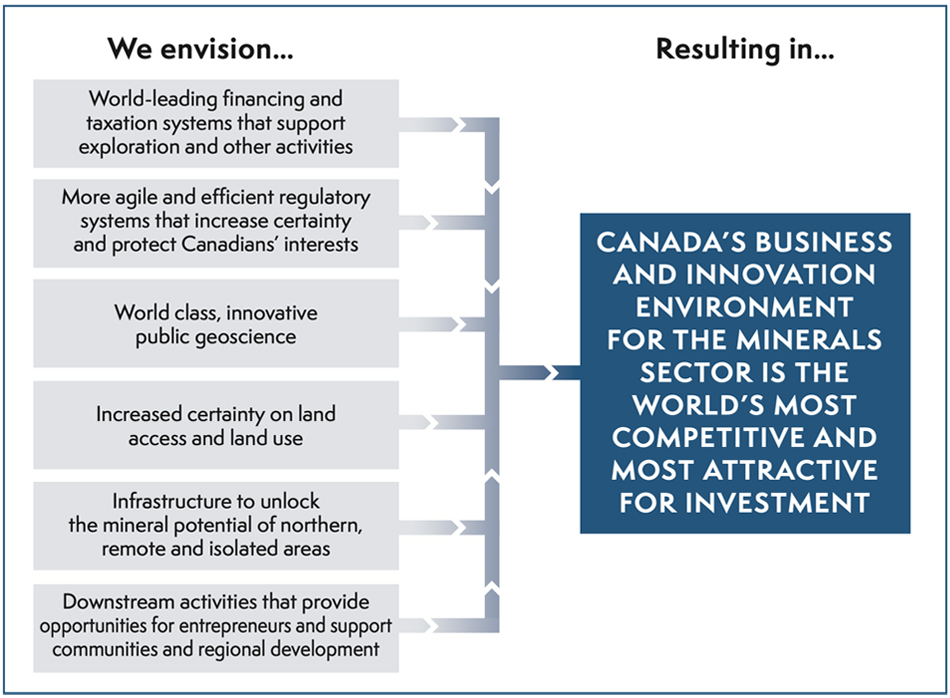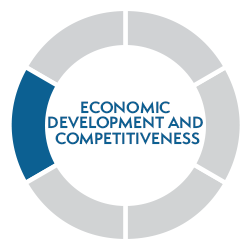Economic development and competitiveness

Text Version
We envision …
|
Resulting in … Canada’s business and innovation environment for the minerals sector is the world’s most competitive and most attractive for investment |
What is the goal of this strategic direction?
- Increase competitiveness to drive success in the Canadian mining sector
- Enable infrastructure investments to unlock resource potential
- Support a new, pan-Canadian, collaborative public geoscience strategy to be implemented by the National Geological Surveys Committee
- Increase regulatory certainty

What are the pan-Canadian initiatives?
The Canadian Minerals and Metals Plan (CMMP) recognizes that high-quality public geoscience reduces risk associated with mineral exploration and supports other stages of the mining value chain, from land-use planning through to reclamation. Consequently, CMMP Action Plan 2020 introduced the Pan-Canadian Geoscience Strategy (PGS) as a key Pan-Canadian Initiative under the Economic Development and Competitiveness strategic direction.
Released in February 2022, the PGS aims to better coordinate geoscience across federal, provincial, and territorial governments. The delivery of more sophisticated and coordinated information increases efficiencies and contributes to shared goals, such as supporting exploration for the minerals that are needed for a clean economy.
Under the National Geological Surveys Committee, the PGS has been developed to strengthen Canada’s competitive position and reflect trends such as digitalization, data exchange, artificial intelligence, virtual reality and other disruptive technologies that support the provision of modern geoscience. The PGS also includes some people-focused elements, acknowledging that impactful geoscience relies on both skilled workers and informed end-users and the public.

Text Version
Relationship between PGS priority areas and the geo-resource value chain
| PGS priority area | Geo-resource value chain |
Land use planning |
Framework geoscience, mineral and energy potential modelling, access to online data, training of next generation geoscientists, public literacy in geoscience |
Licensing and permitting |
Framework geoscience, mineral and energy potential modelling, access to online data, training of next generation geoscientists, public literacy in geoscience |
Exploration and prospecting |
Framework geoscience, mineral and energy potential modelling, access to online data, training of next generation geoscientists, public literacy in geoscience |
Feasibility analysis |
Framework geoscience, mineral and energy potential modelling, access to online data, training of next generation geoscientists, public literacy in geoscience |
Planning and construction |
Framework geoscience, mineral and energy potential modelling, access to online data, training of next generation geoscientists |
Production |
|
Transportation |
Framework geoscience, access to online data, training of next generation geoscientists |
Markets |
|
Reclamation |
Framework geoscience, access to online data, training of next generation geoscientists |
Areas for action
Tax and financial incentives: Review Canada’s tax position and adjust tax policies and other fiscal initiatives to support competitiveness and attract investment.
Land access and land use: Explore ways to increase clarity around land use and access where it does not exist. Decisions should incorporate economic, social and environmental considerations and leverage scientific, local, and traditional knowledge.
Regulation: Encourage harmonization and/or mutual recognition of regulations where appropriate. Develop tools to help stakeholders navigate regulations and ensure capacity exists to deliver advice and decisions from environmental assessments in a timely manner.
Infrastructure: Identify enabling infrastructure needs in regions of high mineral-development potential and dedicate additional resources to unlocking the mineral potential of northern, remote and rural areas.
Mineral processing: Study opportunities to expand Canada’s smelting, refining and pelletizing capabilities to contribute added value to our economy.
Geoscience: Explore options for increased funding for geoscience and examine ways to increase international collaboration on geoscience innovation.
Key actions and resources
To provide certainty for investors and stability for mineral exploration companies and to secure our position as a global hub for exploration and mine financing:
- Mining Incentive Program (N.W.T.)
- Making the B.C. Mining Flow-Through Share Income Tax Credit and the Mining Exploration Tax Credit permanent, and extending the New Mine Allowance (B.C.)
- The Targeted Mineral Exploration Incentive and extending the provincial (METC) (Sask.)
- Junior Mining Assistance Program and Prospector Assistance Program (Nvt., N.B., N.L.)
- Mineral Resources Development Fund (N.S.)
- Reviewing current mining tax regime and fee structures (N.L.)
- Extending the federal Mineral Exploration Tax Credit by five years (Can.)
To develop Canada’s future mines and increase exploration activities:
- Independent Geoscience Technical Advisory Committee (N.L.)
- Prospectors & Developers Association of Canada’s (PDAC) Student-Industry Mineral Exploration Workshop for emerging geoscientists (Assoc.)
- PDAC’s e3 Plus: A Framework For Responsible Exploration (Assoc.)
To position Canada, the provinces and territories as secure and responsible sources of supply and build resilient global value chains:
- Review of critical and strategic minerals (Que.)
- The Canada–U.S. Joint Action Plan on Critical Minerals Collaboration (Can.)
- CMMP study on Canada’s base metals smelting and refining in Canada (Can.)
To give companies and investors certainty and clarity and ensure that good projects can move forward in a timely manner:
- Improving the development assessment process (Y.T.)
- Increasing support for regulatory excellence (B.C.)
- Reduced red tape and modernized regulatory and policy framework (Man.)
- Mineral Economic Development Fund (Man.)
- Rights Coordination Office (Que.)
- Modernizing the Mineral Act and Mining Act (N.L.)
- Harmonized and modernized regulations for regulatory cooperation priorities; implementation of the Impact Assessment Act (Can.)
- Climate-related financial disclosures to provide more information for investors, communities and stakeholders (Can.)
To strengthen communities and enable mining-related activities and regional development:
- Yukon Resource Gateway Project (Y.T.)
- Yukon Mining Alliance (Y.T.)
- Invest Canada North forum (Can., Y.T., N.W.T., Nvt.)
- The Look North campaign (Man.)
- Program for multi-resource roads in the mining sector from the Société du Plan Nord (Que.)
- All-season road connecting western Nvt. and a mineral rich area in N.W.T. (Can., N.W.T.)
- Investing in Canada Plan for hydroelectricity to a mining operation in Western Labrador and the Taltson Hydroelectric Project in N.W.T. (Can.)
- The Mining Association of Canada’s research on the infrastructure deficit in remote and northern regions (Assoc.)
- Memorandum of Understanding on the Sustainable Development of Natural Resources with Argentina (Can.)
- Memorandum of Understanding on the Sustainable Development of Natural Resources with Chile (Can.)
- Memorandum of Understanding on the Sustainable Development of Natural Resources with Mexico (Can.)
- PDAC convention (Assoc.)
